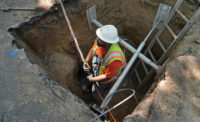Chronic underinvestment has led to a D+ grade on America’s infrastructure report card from the American Society of Civil Engineers. Earlier this year, Senate Democrats threw down a $1-trillion challenge to the new U.S. president: Build infrastructure. Trump countered with his own $1-trillion agenda.
Construction industry leaders recently met in a roundtable format to discuss potential reforms for jump-starting America’s infrastructure development. The event was co-hosted by Stanford University’s Global Project Center and the Stanford Center on Democracy, Development and the Rule of Law.
Participants included executives from major contracting and development companies, infrastructure finance specialists, veteran policy analysts and individuals who recently have held high-level posts in government agencies that are responsible for infrastructure development.
The roundtable identified four important needs for the future of infrastructure policy: renewing federal leadership on infrastructure, more strongly supporting local infrastructure projects, streamlining the process of funding and permitting projects, and shifting toward the long-term, life-cycle value creation of assets.
Roundtable participants see a need for more concentrated resources and decision-making at the federal level. A solution could include a central infrastructure authority to manage nationally significant projects and megaprojects, especially those that require coordination among multiple agencies and are most vulnerable to schedule delays and budget overruns.
This central authority would direct federal investment; consolidate best practices across federal, state and local departments and agencies; and improve efficiency for megaproject delivery. Participants suggested a new, temporary cabinet-level position to create the framework for such an authority to initiate projects.
Canada and Australia, which have state and federal government structures similar to those in the U.S., have solid federal-level leadership for infrastructure development. For example, Infrastructure Australia, an independent body mandated by the government, is responsible for prioritizing and developing significant infrastructure projects in a transparent, rational and apolitical manner, and for providing guidance for procurement and project financing.
Shovel-Ready, Risk-Free Projects
Regardless of federal leadership, inconsistencies between different local government regulations require stakeholders to create one-off processes and stand-alone project documents.
Because local governments often lack capacity and expertise in project planning, front-end development tasks—such as design development, subsurface investigations, rights-of-way, acquisition and other associated risks—are pushed to potential developers. These factors can deter competitive bidding and increase overall costs.
The federal government could also create planning grants or loans to empower local governments to develop shovel-ready projects—those whose risks have already been mitigated—for more-competitive bidding.
Roundtable participants said, “Planning grants can really catalyze a project to get it to go somewhere,” noting that “seeding with small amounts of money can go a long way.” These planning grants could come from a revolving fund, with grant repayment by local governments after projects have begun construction or operation.
Shifting preconstruction risk back to local government encourages local support from a project champion and helps to mitigate political risks. Local governments can then assume the risks they are best suited to handle, such as siting, permitting and environmental approvals, and hand off engineering, construction, operations, financial and innovation risks to other stakeholders.
Most infrastructure is managed by local governments, but a mix of regional, state and federal agencies often interacts with major infrastructure project development. This process leads to a complicated web of disconnected requirements, permits and procedures, with no clear hierarchy, prioritization or sequence.
For example, the recently upgraded Presidio Parkway approach to California’s Golden Gate Bridge is only a mile long, but eight government agencies had direct veto power over the project, and dozens of other agencies could comment on decisions.
Many permitting delays result from disconnected and duplicative processes at different levels. It is unclear, for example, why both federal and some state governments require nearly identical environmental impact statements. These delays create additional costs, lower economic productivity and decrease a project’s social value.
Federal leadership and action can simplify approvals by establishing clear lines of authority among agencies, consolidating processes for environmental decisions, creating a path between agencies to make permitting predictable and accountable, and preempting local and state permits if the process takes too long. Participants noted, “Even in complex projects, all permitting should be done in less than two years.”
Value Creation
Government should shift the emphasis from infrastructure problems and costs to infrastructure benefits and long-term value creation. That means clearly understanding the needs of local stakeholders, establishing metrics for selecting and developing appropriate infrastructure assets, and evaluating infrastructure with objective life-cycle performance measures.
Consider the Ohio River Bridges project between southern Indiana and Kentucky, near Louisville. The initial scope, proposed in the early 2000s, was a 20-plus-year project with dozens of primary contracts. Estimates climbed, cresting at $4 billion, as the scope increased over the next 10 years.
Finally, the forward-thinking governors and state officials focused on innovative ways to unlock real value. To create value, the project team repurposed an old railway bridge for pedestrian and bicycle traffic, thus dropping that element from the new bridge scope and saving money.
Additionally, they designed one bridge for future expansion and leveraged the states’ innovative procurement experience and capacity. Half the project was developed under a public-private partnership in Indiana and the other half under a design-build model in Kentucky. The net result was a $1.5-billion savings from original estimates and a shorter schedule for construction and development.
Like the Ohio River Bridges, when project stakeholders use metrics such as job creation, revenue generation and increased local competition to evaluate projects, private-sector efficiencies can be leveraged. Delivery models that are selected based on these metrics can incentivize stakeholders to create and capture value across the life cycle of an asset.
This process requires greater transparency from both local government and private developers, and a broader network of stakeholders to identify metrics for success. If the local government can identify community needs and build strong consensus among stakeholders, value creation is possible. This, in turn, offers an opportunity for beneficiaries to pay for that value.
Federal policies can guide infrastructure delivery, but continued engagement at the local and state levels improves how infrastructure is delivered. As such, industry partners are in a unique position to engage stakeholders and champion best practices to move infrastructure projects forward.
Kate Gasparro is a National Science Foundation graduate research fellow at the Stanford Global Project Center. She has published work on using public-private partnerships to replace transportation infrastructure. Contact her at kegaspa@stanford.edu.
Andrew South is a Stanford interdisciplinary graduate fellow and senior researcher at the Stanford Global Project Center. He has 10 years of international construction and management experience, including engagement of stakeholders and innovative procurement. Contact him at asouth@stanford.edu.





Post a comment to this article
Report Abusive Comment